 REVIEWS & COMMENTS
REVIEWS & COMMENTS 

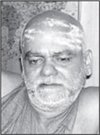 Srimadjagadguru Shankaracharya, Goverdhan Math, Puri, Orissa, India, Sri Swami Nischalananda Saraswatiji Maharaj§
Srimadjagadguru Shankaracharya, Goverdhan Math, Puri, Orissa, India, Sri Swami Nischalananda Saraswatiji Maharaj§
On the basis of philosophy, Sanatan Vedic Aryan Hindu Dharma accepts godliness in all living beings. Vasudhaiva kutumbakam: “The whole world is one family.” All living beings are children of the Immortal Power, God or Ishwara. Hindu Dharma sends out a message for all persons to be free from agony and fear, and to be healthy, happy and pious. ¶The Hindu Dharma is like the holy river Ganga, whereas all other sects, faiths and religions are like canals from Ganga. The existence and utility of all other religions depend upon Hindu Dharma. The Holy Quran, etc., do not recommend cow slaughter. Instead, they support cow protection. In this situation, all those who find their roots in the Vedas, who accept the holiness of the cow and believe in protecting the cow family can become Hindus, while keeping others’ welfare in mind. But it is proper to follow the tradition for social arts, like food, marriage, etc. Based on this principle, any person who has faith in the Vedas, believes that India is a pious land (punya bhoomi), who has sympathy and wants to protect the cow is acceptable to His Holiness as a Hindu. ¶Those have been proselytized by deceptive methods or by physical force must be permitted to go back to their original religion on the principles of human rights. Such persons form the majority of Muslims and Christians in India. They can be brought back to the Hindu fold by creating the proper atmosphere, providing proper facility and by love and affection. ¶Amongst Hindus who have gone astray, due to the influence of Western education, communism, existentialism and materialism, a proper re-education program is required. They need enlightenment in the scientific basics of Hindu philosophy, principles of Dharma Rajya (rightful government) and Ram Rajya (just government). This book, especially the story of Sri Sita Ram Goel, is very educative. Thus, it is proper to give practical form to the principle of becoming Hindu, while keeping a racial and genetic priority in view. This elucidative book will provide immense help to those who wish to enter the Hindu fold, and also the younger generation of Hindus living outside India.§
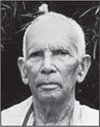 Swami Asimatmananda, for Srimat Swami Ranganathanandaji, President, Belur Ramakrishna Math and Mission, West Bengal, India§
Swami Asimatmananda, for Srimat Swami Ranganathanandaji, President, Belur Ramakrishna Math and Mission, West Bengal, India§
Revered Maharaj appreciates this honest effort to guide sincere seekers wishing to follow the Hindu way of life. He points out that the doors of Hinduism had been kept closed to “outsiders” for centuries. Swami Vivekananda himself gave his famous call to Hindus to broaden their outlook. One of his interviews on conversion has been qouted in detail in the book. There are many devotees associated with the Ramakrishna Order who were not born into the Hindu faith but have accepted Hindu names of their own accord. Scores among them have gone on to take, and faithfully keep, formal lifelong vows of brahmacharya and sannyasa. ¶The Prabuddha Bharata, the monthly English journal of our order, has been serializing, since February, a transcript of a question and answer session conducted by Revered Swami Ranaganathanandaji Maharaj at Chicago, in1982, at the request of the local Vedanta Society. In it, several questions pertaining to Hinduism, including about conversion, have been answered by revered Maharaj. Revered Maharaj conveys his love to Satguru Swamiji as well as to all the inmates of Kauai’s Hindu Monastery. §
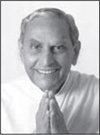 Dada J.P. Vaswani, head of the worldwide Sadhu Vaswani Mission, renowned Sindhi religious leader and eloquent lecturer, Pune, India§
Dada J.P. Vaswani, head of the worldwide Sadhu Vaswani Mission, renowned Sindhi religious leader and eloquent lecturer, Pune, India§
True conversion is not a mere change of label but an inner transformation of mind and heart. The great task that lies ahead of us is that of converting Hindus—in India and abroad—into true Hindus, acutely aware of the rich heritage that belongs to them as children of the ancient rishis of Bharatvarsha. The emphasis of the rishis was not on words but on life. When the Hindus bear witness in deeds of daily living to the great ideals of Sanatana Dharma, then indeed will India shine once again in the splendor of the new morning sun. Hence the value of How to Become a Hindu. It has been written with clarity of thought, perceptivity of mind, a depth of feeling and a great sense of commitment. It answers many questions that perplex the youth of today. ¶India is passing through a dark period of her destiny, because Hindus have forgotten how to live as Hindus. They need to be taught the truths proclaimed by their prophets and avataras and by Him who said, “Renouncing all rites and writ duties, come unto Me for single refuge. I shall liberate thee from all bondage to sin and suffering. Of this have no doubt!” Millions of Hindus are waiting to be converted into true Hindus. I am one of them. I welcome this publication and breathe out an aspiration that it may find a place in every Hindu home—and heart.§
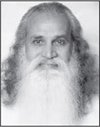 Sri Swami Satchidananda, Founder/Spiritual Head of Satchidananda Ashram; Founder, Light of Truth Universal Shrine (LOTUS); renowned yoga master and visionary; Yogaville, Virginia§
Sri Swami Satchidananda, Founder/Spiritual Head of Satchidananda Ashram; Founder, Light of Truth Universal Shrine (LOTUS); renowned yoga master and visionary; Yogaville, Virginia§
Since ancient times Hinduism has been known as Sanatana Dharma, which means the Eternal Truth. As such, the Hindu religion has a long history of accepting anyone and everyone who is on the path toward eternal truth. Hinduism does not discriminate against any sincere seeker. Whosoever is devoted to the search for that Eternal Truth is embraced by the religion of Hinduism. Therefore, Hinduism is perhaps the most universal and welcoming faith of all time. ¶How to Become a Hindu, by revered Satguru Sivaya Subramuniyaswami, is the first authoritative book to give those who wish to embrace Hinduism more formally and more fully all the inspiration and guidance to enable them to do so. This book is encyclopedic in its breadth and depth, answering any and every question regarding Hindu faith, its beliefs and rituals. Finally, there is a book that teaches aspirants how to embrace the faith that is always ready to embrace the true seeker..§
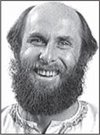 Pandit Vamadeva Shastri (Dr. David Frawley), Vedacharya; Director of the American Institute of Vedic Studies; Author, How I Became a Hindu; Santa Fe, New Mexico§
Pandit Vamadeva Shastri (Dr. David Frawley), Vedacharya; Director of the American Institute of Vedic Studies; Author, How I Became a Hindu; Santa Fe, New Mexico§
Many people throughout the world are attracted to the Hindu religion because of its great yogis and powerful spiritual practices. However, if they want to become Hindus, they are told, even by Hindus, that it is not possible. Or, if it is possible, they are not given an easy way to do so. The result is that people looking for a higher religious identity, such as they see in Hinduism, will become Buddhists or try to accommodate themselves to their original religious backgrounds that they found wanting in the first place. ¶Many people have the misconception that Hinduism does not take on new members, and some Hindus seem to confirm this. They identify Hinduism with caste or with some India-based ethnicity, not with a global religion, though this has always been its basis as Sanatana Dharma, the universal or eternal tradition of truth. ¶Now at last a modern Hindu teacher addresses this issue of conversion to Hinduism directly, with kindness and sensitivity, yet firmness and clarity. In How to Become a Hindu, Satguru Sivaya Subramuniyaswami shows sincere seekers a clear and practical path to enter into humanity’s oldest and broadest spiritual and religious tradition—to forge a direct connection to great yogis and rishis that they have long admired. ¶As perhaps the world’s foremost Western-born Hindu guru, Sivaya Subramuniyaswami himself provides the best example of what is possible through formally becoming a Hindu, as do his many Western swamis that bring out HINDUISM TODAY, the world’s most authoritative magazine on Hindu Dharma. ¶All students of Hindu-based teachings, like yoga, Vedanta, Vedic astrology or ayurveda, should examine this book to understand the background tradition that their disciplines are based upon and which may be necessary to facilitate their deeper practices. All Hindus, particularly those who don’t know how to explain their many-sided religion, should read this book to find out how to do so. All those interested in the religions of the world should examine the book carefully to correct the rampant misconceptions about Hinduism that have been fostered by missionary creeds. ¶The world would do better with more Hindus. The Hindu religion is notably more diverse, tolerant and mystical and contains a much greater variety of spiritual teachings than larger, better funded and more aggressive faiths. It represents the native and pagan traditions of the world that contain the key to the older and more experiential spirituality of humanity that so many people are looking for today. ¶With more real Hindus the world would be a kinder and more understanding place to live in, with yoga and meditation as the foundation of human life and culture. Those who accept the Hindu religion from the point of view set forth in How to Become a Hindu will be better able to spread its universal message of not only One God but One Self in all beings. Let us hope that this book travels far and wide, not only outwardly but also in the minds, hearts and souls of all people.§